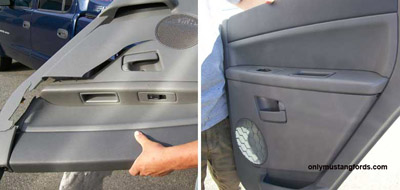Interior Rear 1/4 Panel Plastic Restoration
(Houston, Texas)
Question Re: Interior Rear 1/4 Panel Plastic Restoration
I appreciate the DIY Vinyl dye restoration, I realize that I may have to do some Vinyl work to restore my Mustang.
The issue that I have with my 1993 Mustang hatch, is that the Opal Grey interior was only offered in 93 and the rear 1/4 panel plastics need some restoration.
But I noticed that there are some cracks in the plastic and am wondering is there a way to repair the cracks in the plastic? I've tried looking for the trim pieces, new (with no luck obviously), looked for them used but are a hassle to get shipped and will cost a few hundred $$$, so I figure I can restore them myself and save myself $$. And I have the benefit of maintaining the original components.
If anyone comes across this and has any ideas, I would greatly appreciate an email: garcia_n_888 at hotmail dot com (altered to help prevent web spam) B.
Answer:
It's unfortunate you couldn't provide some pictures of the cracked areas on your plastic rear quarter panels, but I can offer you some quarter panel restoration tips for getting them back to almost new condition.
Check out the image above to get an appreciation of just how bad a crack can be fixed in the right hands!
That one was repaired by a professional, but here's a procedure you can try.
Part 1 - Structural Repairs:
First, start off by repairing the cracks in the panels from behind. There are several good products out there that you can use. One that I like is found at most auto parts stores, or body shop supply places. It is used to repair cracks in plastic bumper covers.
The repair kit includes a resin that you mix and apply to the roughed up surface of the plastic. For big cracks, like you see in the photos above, it's critical to reinforce the cracks from behind, as well as gluing the separation line.
You can do this with a small strip
This adds strength to the repair and prevents future problems.
Plastic Weld, is one make, but there are several others.
Part 2 - Making the repair invisible
What the pros do, is just like a real weld, sand down the cracked edges on a slight angle and fill the cracked area with the plastic putty, smoothing it down until it's very close to the surface height.
Then, they apply a second layer of filler to the top, which has grained paper, that is relatively close to matching the OEM grain pattern, and pulled off just as the material sets, leaving a seamless look.
Then, you will use an appropriately matched color vinyl dye to spray the entire surface to achieve a nearly unnoticeable repair.
Home Made Alternatives
Repairing cracks, in your plastic quarter panel can also be done, with reasonable success using a glue gun and plastic or mesh backing for reinforcement. It sticks like crazy and is also pliable.
If your cracks are not in plain view, you can fit and tape the pieces tightly together before gluing. This makes most of them almost disappear if you get your alignment right.
And if necessary, you can re-dye the panels on both sides to further hide the repairs.
If you're a bit more artistic and daring, you can also angle sand the pieces, fill them with the bumper weld filler and then CAREFULLY, using an Exacto knife, make your own grain texture to hide the repairs.
If All Else Fails? Go With The Pros
And if you don't feel confident doing it yourself, there are a number of companies around that will do interior or vinyl repair. The picture of the interior panel repair is one who has fixed some of my Mustang door panels, and in my opinion, is actually better at repairing newer door panels, like those from your 1993 hatchback.
All the best!
Anyone else had success doing it differently?
Return from Interior Rear 1/4 Panel Plastic Restoration to Ford Mustang
Join in and write your own page! It's easy to do. How? Simply click here to return to Contact Me !.

